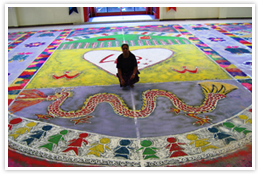|
|
| |
 |
 |
|
 |
| |
 |
Singa Rangoli |
 |
|
| |
 Singapore’s culture is derived from its immigrants who left the safety and security of their own shores to set up shop in Singapore. The seeds of Rangoli were sown in India but the seeds travelled to Singapore and due to the strong desire of Singaporeans to maintain the culture and tradition of their homeland the art of Rangoli continued to get active encouragement in Singapore. Singapore’s culture is derived from its immigrants who left the safety and security of their own shores to set up shop in Singapore. The seeds of Rangoli were sown in India but the seeds travelled to Singapore and due to the strong desire of Singaporeans to maintain the culture and tradition of their homeland the art of Rangoli continued to get active encouragement in Singapore.
The art adapted from the traditional drawings into Rangoli collage glued on plywood boards, stainless steel tiles, pvc cured sheets, acrylic sheets both indoors as well as outdoors. It climbed walls and ended up on the ceiling. Besides the traditional Collages using rice flour, sand, marble chips and saw dust it experimented with a wide range of grains like wheat, corn, sesame seeds,salt, fruits and vegetables, household items like matchsticks, paper clips, bottles and bottle caps, hairclips etc.
The peacock, because it is a harbringer of rain and is a very colourful and pretty animal is commonly featured in major Rangolis. In Singapore the Merlion continues to attract people because of the myths attached to it and is a symbol of Singapore’s prosperity and National unity and has been widely featured alongside the Peacock in many of Vijaya’s Rangoli. For Vijaya thoughthis Art was born in India it has evolved in Singapore and through its evolution into the contemporary with forays into decorative and paintings on canvas has finally come into its own and is aptly called SINGARANGOLI. |
| |
|
|
|
 |
|
 |
|
|
| |
|
|
|